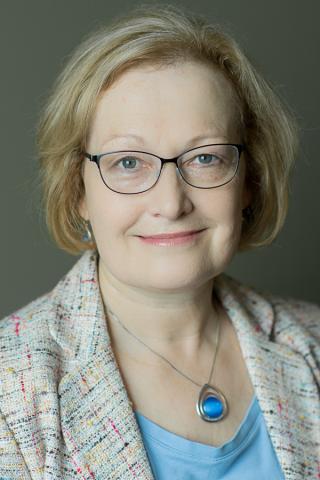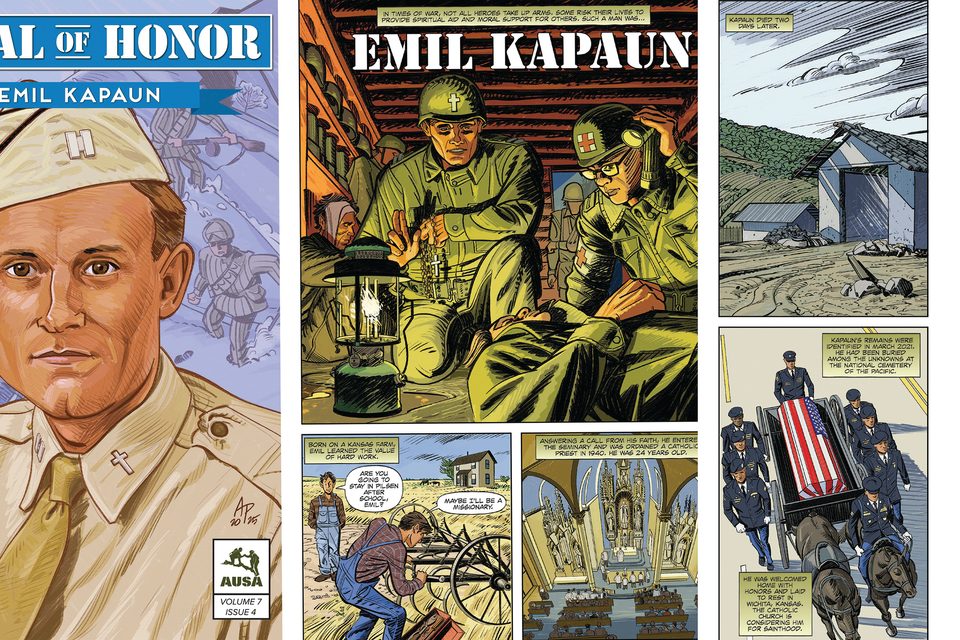The new chaplain of St. Francis of Assisi Deaf Catholic Church in Landover Hills, Maryland, steps into the position with a lifelong understanding of what it means to be Deaf and an intense interest in ensuring that deafness be treated as a culture, not as a disability.
Father Min Seo Park arrived in the United States from his native Seoul, South Korea, in late January to take up the triple job description of serving as chaplain at St. Francis of Assisi, as chaplain to the Catholic community at Gallaudet University and providing pastoral ministry to the Archdiocese of Washington’s Deaf population overall.
The challenges seem well within the capabilities of a priest who is fluent in four languages -- Korean Sign Language and American Sign Language, or ASL, as well as written Korean and English. He also is one of fewer than two dozen Deaf Catholic priests in the world and built a Deaf Catholic parish in Seoul, including raising the funds for both the land and the building.
He spoke with the Catholic Standard at the archdiocesan offices of the Center for Deaf Ministries, with the sign language interpretation assistance of the center’s director, Mary O’Meara, who serves as the executive director of the Archdiocese of Washington’s Department of Special Needs Ministries.

Using American Sign Language, Father Min Seo Park celebrates an Ash Wednesday Mass on Feb. 17, 2021 at St. Francis of Assisi Deaf Catholic Church in Landover Hills. (Photo by Joe Portalano)
Father Park, 52, is actually returning to Washington, having arrived the first time in 1994 to study ASL and English in Gallaudet University’s English Language Institute, before beginning his undergraduate degree there a year later. Gallaudet is the only higher education institution in the world where all students live and learn in ASL and English. It has a robust program for international students.
Deaf since an illness at the age of 2, he grew up attending schools for the Deaf. Not raised a Catholic, he went with schoolmates to Protestant churches with signing ministers at first. Eventually, a Deaf Catholic art teacher introduced him to a Catholic parish near the Deaf school, where he joined a Bible study for the Deaf and became a Catholic at age 17. With few priests in Korea who used sign language, however, he and other Deaf Catholics found the experience frustrating.
“Deaf Catholics and I did not understand clearly what the priests said,” he explained. “Some of them were not happy and eventually converted to Protestant churches.”
That opened up his path to a vocation. “When I was praying alone in front of Jesus Christ on the cross at the chapel, I asked Him if he could send a signing priest for the Deaf,” Father Park said. “However, suddenly I felt that Jesus said to me, ‘Why not, you…’ I said, ‘Me?’ That is how I began to consider the priestly vocation.”
A hearing priest who knew sign language, Father Michael Jeong Soon O, helped him connect with Father Thomas Coughlin, the first Deaf priest ordained in the United States, who pointed him to Gallaudet.
He came to Gallaudet after completing an associate’s degree in design and working for two years as an animator and for three years as a pastoral worker for the Seoul archdiocese’s Deaf church, he said.
At Gallaudet, he studied math and philosophy, graduating in 1999. With the encouragement of Father Coughlin he went on to study theology at St. John’s Seminary in New York.
“I began to study with the theology students, where I had to read each lecture as it was being transcribed for me,” he said. Without a sign language interpreter, the school’s initial approach was to assign someone to sit in the classroom and transcribe the teacher’s words, while he read along. “My English was not as strong as it could be, and I struggled to keep up,” he said.
After that first course, however, the seminary provided sign language interpretation, making it easier to stay on track. He completed his masters of divinity degree in 2004 and returned to Seoul.
There, he began his theology studies for the Archdiocese of Seoul. He was ordained to the priesthood there in 2007.
It was not an easy life to be the only Deaf seminarian in both New York and Seoul, Father Park said. But many people helped him fit in. At the seminary in Seoul, he was given the assistance of interpreters available 24 hours a day. And there were two or three other seminarians who knew sign language.
“I did teach a lot of the seminarians sign language, too,” he said. By the time he graduated, the group of signing seminarians had grown to 10. His ordination immediately helped fill a gaping need.
He said that as he celebrated his first signed Mass after ordination, he saw a congregation of joyful people. “Some Deaf people, who were poor at Korean writing and could not communicate with non-signing hearing priests, had not confessed to priests for many years, like 20 years,” he said. With him, “they felt confident and comfortable to confess to me in sign language. I was happy that I forgave their sins through the sacrament of Confession. Deaf people witnessed my priesthood ordination and realized that Deaf people were children of God as well. They felt joyful and happy to listen to the Word of God, the Gospel from me, a Deaf priest. “
Over the next 14 years, Father Park built up the Seoul Deaf Catholic community, giving them – indeed, giving all of South Korea -- their first priest who is what is referred to as culturally Deaf.

Father Min Seo Park participates in a recent interview with the Catholic Standard at the Archdiocese of Washington's Center for Deaf Ministries in Landover Hills. (CS photos/Andrew Biraj)

Lana Portolano, author of “Be Opened!: The Catholic Church and Deaf Culture,” and an English professor at Towson University in Maryland, explained in an email exchange that Father Park is one of fewer than two dozen Catholic priests worldwide who use signed language as their primary form of communication. Nine of them are in the United States.
Complex factors are involved in why there aren’t more Deaf priests and why about half of them are in the United States, Portolano said. For instance, due to strong disability rights laws, education overall has more support for ASL interpreters, helping the United States to have more Deaf priests than most entire continents. As Father Park discovered, seminary education requires interpreters in classes, for prayer, social life and every other function in a non-signing community. It’s a costly form of support that is out of reach in some countries.
“In addition to the cost and some bishops' hesitance, the mainstream culture in many countries today still retains prejudice against Deaf people -- including the ridiculous idea that Deaf people are unable to learn as much as hearing people, or that they are automatically ‘dumb’ because they are Deaf,” Portolano said. “This can leave a whole group of people -- the Deaf population -- unserved by a priest who can communicate, lead worship, or teach the Gospel in the only language these people are able to use in face-to-face communication. Many Deaf people around the world go their whole lives believing that the Church is only for hearing people.”
Most Deaf Catholic communities experience Mass with a sign language interpreter or sometimes with a hearing priest who can celebrate using sign. This can pose problems with hearing Confession, for instance. And an interpreter is typically at one side of the room, meaning that a Deaf person who is following the signing cannot simultaneously watch the actions of the priest at the altar.
In a December 2009 article for New Theology Review, Father Park wrote about deafness as a cultural difference, rather than a disability.
“Many hearing people feel that Deaf people are disabled persons because they do not have the sense of hearing,” he wrote, in an article derived from his master’s thesis. “However, even though Deaf people cannot hear, they can communicate in sign language or use an oral method. Therefore, from the perspective of Deaf culture, a sense of hearing is not necessary for Deaf people.”
He continued: “A Deaf person communicates with Deaf people in sign language. However, when the Deaf person meets hearing people, he or she may not communicate well with hearing people using an oral method because often his or her oral speech is not good. Should hearing people think that such a person is a disabled person? For example, consider what happens when a hearing person meets Deaf people. He or she cannot communicate with the Deaf because he or she does not know sign language. Should he or she think that Deaf people are disabled persons? Rather would not Deaf people think that the hearing person is disabled? If hearing people, who do not know sign language, believe that Deaf people are persons with disabilities, then hearing people should realize that they are also disabled.”
Portolano explained that in addition to the few culturally Deaf priests in the world, there are many others who have hearing loss and can communicate in person with residual hearing and lip-reading.
“There must be hundreds of priests who were once hearing but, as they age, become Deaf,” she said. “Some of them may even know a little sign language. The difference between these and the culturally Deaf priests is that they communicated easily for most of their lives in spoken language before losing their hearing, and do not sign the Mass.”
As Father Park discovered when celebrating Mass for the Seoul Deaf community, even with a signing priest, a crowded church itself can be an obstacle to Deaf participants.
With a congregation of 200 people in a small space, “I had to stand on a chair so the people in back could see me sign,” he said. That led him to begin a campaign to get the entire Seoul Catholic community to support buying land and building a dedicated church for the Deaf population.
“I went to 150 parishes and spoke to them about the needs,” he said. And he did that twice, once to raise the money to buy a piece of land and then to finance the church construction. That was completed in 2019, just about the time Father Park came to the United States for a visit and O’Meara began discussing with him the possibility of coming to work for the Archdiocese of Washington. Obtaining the necessary visa for Father Park itself was a two-year process, she said.
Since his return, he’s been refreshing his English and his ASL, after 14 years of communicating in Korean Sign Language, which is, he said, 95 percent different from ASL. In addition to renewing his familiarity with the Washington area and the United States, Father Park is looking forward to being in a country where there are other Deaf priests like himself.
“They all go on a retreat together in September,” he said, his eyes brightening as he signed. “I’m very excited to join them.”














